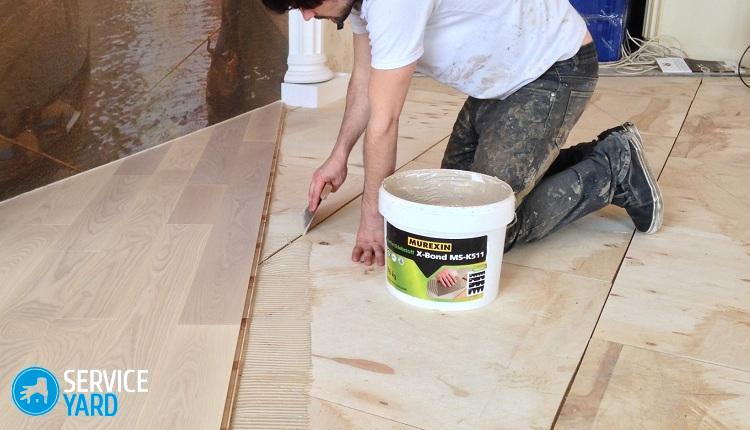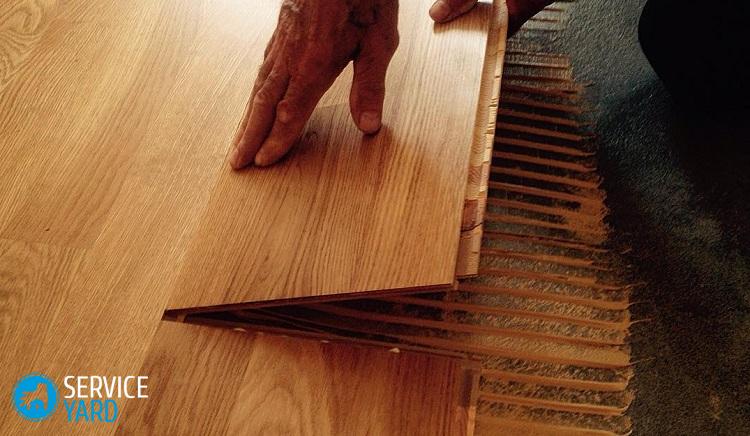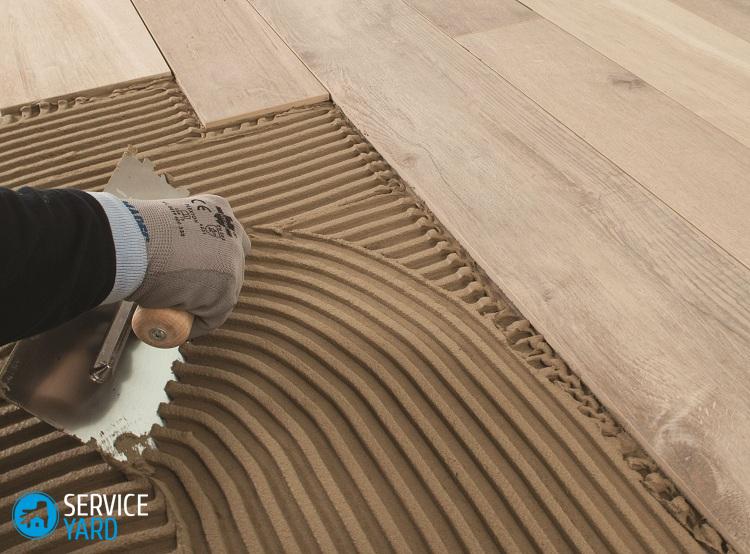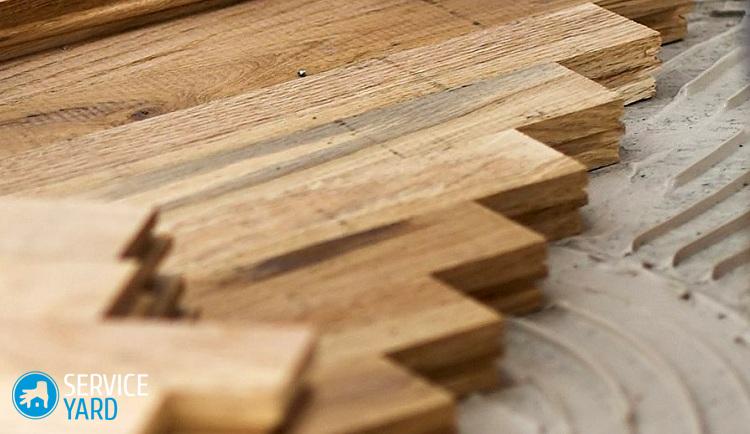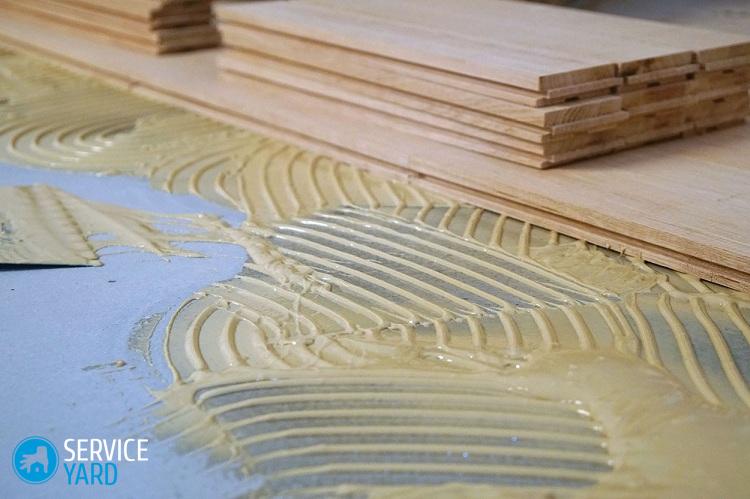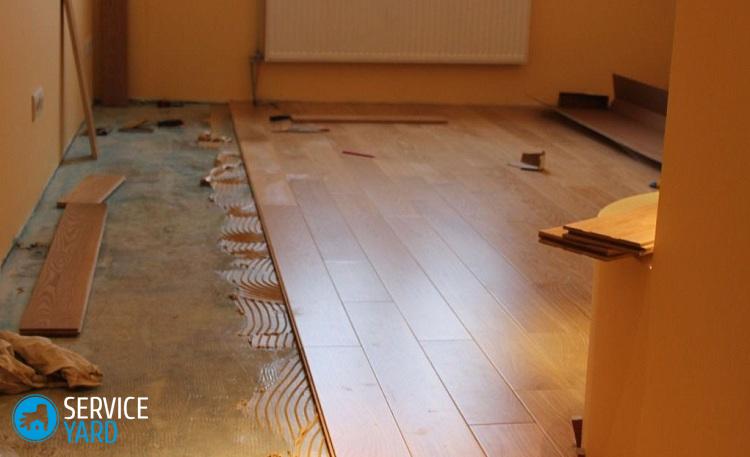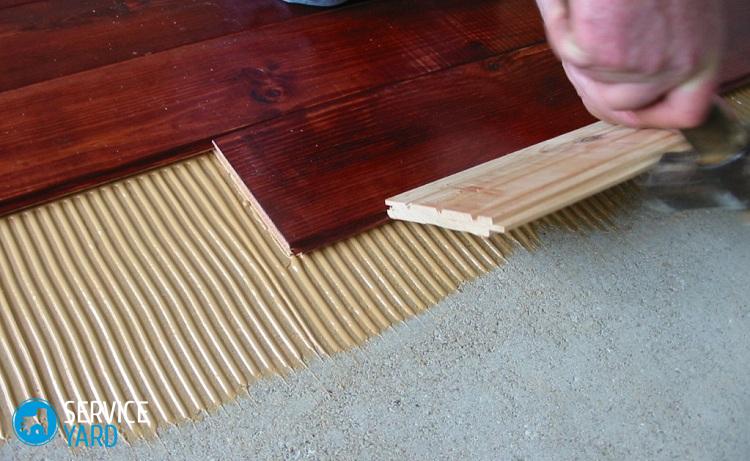Parquet board adhesive
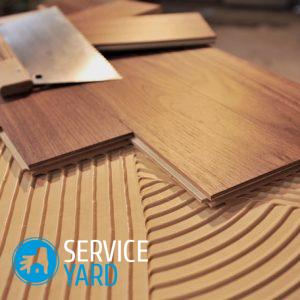
Everything should be beautiful and comfortable in a house or apartment - from the ceiling to the floor. And here not only a good interior plays a big role, but also a quality repair. To achieve this, you need to carefully select materials for the work - at this stage it is better not to save costs. As for a well-laid floor - a parquet board, not only a competent choice of the main material is important here, but also what kind of glue for the parquet board was used in the work. Therefore, in this review we will tell you everything about such an important composition for repair and how to glue parquet on different grounds.
to contents ↑Primary requirements
Parquet board is most often made of wood, and it is capricious, can be deformed during operation for various reasons. This can be either mechanical stress or an increased level of humidity. To minimize their impact, you need to correctly select glue for laying parquet.
It must meet the following requirements:
- The composition should be a minimum water content. In excess - the boards swell even before the start of operation. This leads to the appearance of waves on the surface and to damage to the outer layer. Even when the panels dry out, they may not restore their original shape, and repairs will have to be redone.
- The adhesive for the floorboard should give minimal shrinkage. If you apply a thick layer of the composition to the board, and after drying it will significantly decrease, then the coating density will be impaired. Gaps will appear between the panels, and even worse, the floor will begin to creak.
- As we have said, wood is a material that quickly gains moisture. Temperature differences also affect it. Lamels can slightly increase and decrease in size. Glue, in this case, should provide mobility to the material. Otherwise, you will again encounter the appearance of waves on the surface.
- The service life of the adhesive should be long and consistent with the service life of the parquet board. If the lamellas, due to lack of adhesion, begin to peel off ahead of schedule, the restoration will cost a pretty penny. In addition, it will be quite difficult to choose the right color boards.
- The adhesive should not contain hazardous toxic substances. Harmful additives, even in small quantities, will begin to produce evaporation. And this in living quarters can lead to health problems.
- If you are thinking about the question of how to glue parquet to concrete, then pay special attention to such a property as adhesion. The adhesion of materials in this case should be high-quality and strong.
to contents ↑Important! If you yourself do not know how to choose the best adhesive for the floor, then ask for advice from the seller. According to the law on the protection of consumer rights, each of them must know the main characteristics of the goods sold in order to give a full description of the materials.
Types of glue
If you decide to abandon the “floating” method of laying panels, and settled on the adhesive method, then when choosing a material, focus on the base of the floor. In the assortment of construction stores, compositions suitable for laying lamellas are presented:
- on concrete screed;
- on a wooden base;
- universal materials.
Also, the adhesive for laying parquet is divided into dispersion, one-component and two-component compositions. We will consider them in more detail later in the text.
to contents ↑One component
The main advantage of one-component materials is that they are sold ready to use. In such compositions, you do not need to add additional components, measure out the necessary proportions, which saves time. In addition, they are inexpensive and are great for living quarters.
Dispersion composition
One-component adhesive for water-dispersion-based parquet boards is the most budget-friendly material of all. It has both cons and pros:
- The dispersion material incorporates cellulosic acid or acrylic. These additives are absolutely harmless, do not give a pungent odor, are easy to apply and are also easily cleaned from lamellas. This eco-friendly material is very popular in Europe.
- But he also has a major drawback: water is the main component of the material. And it, as we have already found out, leads to deformation of the parquet. Therefore, dispersion glue can be used only for boards made of moisture-resistant wood - larch, oak, oily wood.
Important! Not the last role is played by the thickness of the board itself. It should be at least 10 mm. Otherwise, the board absorbs moisture from the glue, the floor swells, and can even change color.
- The disadvantages also include the fact that the use of such a composition requires a lot of time. It is applied quickly, but it may take a week to completely dry the surface.
Important! Dispersion adhesive can only be used on untreated board surfaces. It is also impossible to carry out work with its use in cold rooms. Otherwise, the water will not evaporate, and the lamellas simply do not stick to the surface.
Rating
To facilitate the selection, here are three of the most popular water-dispersion compositions that have already proven themselves in the work:
- Glue for a parquet board BONA B-720 from manufacturers from Switzerland. A can weighing 22 kilograms will cost 100-110 cu This material is enough for surface treatment of approximately 20 square meters. The water content in this glue is 22%, which is suitable for working with oak and larch, which must be glued to the base of plywood.
- Manufacturers of the Kiilto Standard brand put up for sale jars weighing 17 kilograms at a price of 90 cu This composition has a more economical consumption - 600 grams per square meter. It has a very high water content of 36%, so this glue is only suitable for working with dense wood.
- Another popular composition is vinyl adhesive for water-based parquet boards from Russian manufacturers called Tarbikol KP 5. It is available in 20 kg containers at a price of $ 70. 700 grams can be enough to process a square meter of floor. Its main feature is the thickness of the lamellas should be no more than 15 mm. The main advantage is the ability to use in underfloor heating.
Solvent Based Composition
One-component compositions also include adhesive for laying parquet, which is based on solvents. These are additives in the form of rubber, polymers or artificial resins:
- Due to the lack of water in such compositions, they do not cause deformation of materials. This adhesive is ideal for parquet boards on plywood and even on a concrete base. Grip will be reliable, and the surface will withstand various influences, including mechanical ones.
- Additives that are not toxic give the necessary elasticity. The surface, even with sharp fluctuations in temperature, will not deform and will not go in waves.
- Another positive property of this glue is its fluidity. If something went wrong during the repair, you can adjust the position of the lamellas, because the composition does not harden in air for a quarter of an hour.
- What gives advantages to the composition gives it disadvantages as well. Supplements, although not toxic, are synthetic, which makes the glue flammable. Work with it near open sources of fire is prohibited.
Important! Solvent-based glue has a pungent odor that can cause respiratory irritation.Therefore, when working with such materials, it is necessary to use protective equipment, and after laying the flooring, the room should be well ventilated.
Rating
Materials with the addition of synthetic components will cost more than dispersion ones. But they have more advantages. Among all the variety represented on the building materials market, we advise you to pay attention to the following grades of adhesive for laying parquet:
- UZIN-MK 73 glue is made on the basis of synthetic resins. On the shelves put up in a bank with a capacity of 25 kilograms, for which you have to pay from 120 dollars. This volume is enough to process a room from 25 to 30 square meters. This composition better than anyone else solves the issue than gluing parquet to concrete.
- Ansercoll glue is the most environmentally friendly in its class, as it is based on organic solvents. On sale is represented by a volume of 23 kilograms, which will be enough to accommodate up to 28 square meters. The cost of the composition is from 50 cu When processing wooden surfaces, it does not cause a change in color and structure, perfectly glues lamellas for both plywood and screed.
- The Russian manufacturer, representing the Tarbikol KPA brand, is also a leader here. He produces a composition that is used both in working with unprocessed and varnished elements. In addition, the price is quite budget. A can weighing 21 kilograms will cost 40 cu And the expense is the most economical - from 600 grams per square meter. By the way, this glue is suitable both for concrete and plywood, and for laying lamellas on a tiled base.
Two component formulations
This adhesive for parquet boards is also called reactive, because in this case hardeners are added to the original composition. Both components are sold in different containers. Due to the chemical reaction when they are mixed, a bonding process occurs. This connection gives a lot of advantages, but there are also disadvantages:
- The adhesion between the surfaces is strong and solid, therefore, two-component compositions can be used on slats of various thicknesses and even for boards with a varnish coating.
- The glue dries quickly, while it has excellent elasticity, which allows you to get a surface with a long service life. The same high rates relate to characteristics such as various mechanical stresses and shrinkage.
- The main disadvantage of this composition is its high price. This is the most expensive type of glue for the floorboard.
Important! To prepare this composition, you will need a mixer to evenly mix all the components. You need to use the mixture for a maximum of half an hour, while the chemical reaction is ongoing. It is impossible to store glue even in a closed container, because its further use is impossible.
Two-component compositions are divided into two groups:
- Epoxy-polyurethane has a pungent odor. Its cost is relatively small, and the application gives an elasticity of up to 20%.
- The polyurethane mixture is practically odorless, as it does not contain toxic substances. It is more expensive, but also has a higher strength, after hardening it retains elasticity in the range of 30-40%.
Important! It will not be amiss to recall that any use of glue for a parquet board requires the use of protective equipment - respiratory organs, organs of vision and skin. The exception is only dispersion compositions.
Rating
Any of the two-component compositions quickly sets. The glue completely hardens in 1-2 days and gives a very strong fixation of the lamellas with any base. And here the following manufacturers showed themselves best:
- The polyurethane composition of Tabicol PU 2K can be used in working with a wide variety of parquet boards. Size, thickness, texture do not matter. It is used for laying slats on plywood, concrete and tile. For a jar weighing 10 kg will have to pay a minimum of $ 50. Consumption is not entirely economical. Per square meter of surface to be treated, 800 grams are needed.
- In second place in popularity is also a polyurethane mixture under the brand name Wakol PU-210. It is also considered universal, because it firmly glues various types of boards with any base. The price of a 7 kg can starts at $ 20 Consumption is the same as the leader of the rating.
- Bronze for ACM VK-L12 glue, which is made from a mixture of epoxy resins and polyurethane. For 10 kg of the composition, sellers ask for $ 30. Consumption is 800 grams per square meter of area. But there are limitations in application: such glue is suitable for parquet boards from different breeds, but the width of the lamellas should be small.
findings
Now that you know what types of glue for a parquet board exist, we will briefly talk about the reasons for which they are suitable:
- If the base is made of plywood, then it is worth considering that this material is afraid of moisture and is deformed from its excess. For this reason, dispersion formulations are not suitable for such a rough finish. In this case, it is best to use one-component adhesive for parquet boards on plywood, for example, with polymers.
- But if you are wondering how to glue the parquet to concrete, then you should not remove the dispersion composition from the list of materials used. Screed absorbs excess water. A minimum of moisture will get on the board, and this will not lead to significant deformation of the coating. Also, for work on a concrete base, a one-component rubber-based composition with the addition of polymers and two-component adhesives are suitable.
- A base such as self-leveling floor does not absorb moisture. Therefore, dispersion compositions for him will not work. The best choice in this situation for standard lamellas will be solvent-based glue, for large-format ones - a two-component composition.
As for operating conditions, everything is quite simple here:
- Dispersion adhesives are recommended in the bedroom, living room or study. The loads in these rooms are low, humidity is also, the temperature is usually stable.
- In the kitchen or in the corridor, glue on the solvent will be more appropriate - here the effect of moisture is stronger, and the load is higher, so the glue layer must be very elastic and strong.
- In the bathroom, hallway, on an unheated balcony, it is best to glue the coating with a two-component composition that has the highest strength indicators.
Stock footage
The range of adhesive for laying parquet, which today can be seen in building materials stores, is extensive. For beginners who are first faced with repairs in their apartment, you can easily get confused. The main thing - when choosing formulations to pay attention to the added components. And, of course, take into account on what basis the laying of the parquet board will be made. In order not to spoil the expensive coating, you need to pay attention to proven brands that have been present on the construction market for more than a year.
- How to choose a vacuum cleaner taking into account the characteristics of the house and coatings?
- What to look for when choosing a water delivery
- How to quickly create comfort at home - tips for housewives
- How to choose the perfect TV - useful tips
- What to look for when choosing blinds
- What should be running shoes?
- What useful things can you buy in a hardware store
- Iphone 11 pro max review
- Than iPhone is better than Android smartphones



